Gosport and Fareham Tramways
History
Gosport and Fareham Tramways were owned and operated by the Portsmouth Street Tramways Company, which was a subsidiary of the Provincial Tramways Company. The PTCo was founded in 1872, and over the course of its fifty years of tramway operation would at one time or another either own, control or operate: Borough of Portsmouth, Kingston, Fratton and Southsea Tramways; Cardiff Tramways; Cardiff District and Penarth Harbour Tramways; General Tramways of Portsmouth; Gosport Street Tramways; Gosport and Fareham Tramways; Great Grimsby Street Tramways; the Landport and Southsea Tramway; London Southern Tramways; Plymouth, Stonehouse and Devonport Tramways; the Portsdown and Horndean Light Railway; and Portsmouth Street Tramways.
In the late 1890s it was clear to the PTCo that Portsmouth Corporation would compulsorily purchase all the company's lines within Portsmouth (as well as its Cosham line, which was just to the north of the borough), leaving it with the small system in Gosport. Although the latter was also threatened by municipalisation, it escaped this fate due to the local authority — Gosport and Alverstoke Urban District Council — failing to follow the process laid out in the Tramways Act, 1870 (when serving notice on the company in late 1900).
On the 31st December 1900, the PSTCo duly lost all its lines within Portsmouth, which left it to ponder what it should do with its Gosport operation. During 1901, it decided to offload the tramway by offering it to the Urban District Council, but was rebuffed. Somewhat reluctantly, the PSTCo then decided to proceed with a scheme to convert the horse tramway to overhead electric traction, and to extend it northwards to Fareham, and southwestwards to Bury Cross (an additional 5.7 miles in total). Powers to this end were granted on the 11th August 1903 under the Gosport and Fareham Tramways Act, 1903.
Although construction of the new overhead electric tramway commenced in early 1905, there was insufficient time to complete the authorised line in the time allowed by the 1903 Act. The company was therefore forced to apply for an extension of the time, this being granted on the 4th August 1905 under the Gosport and Fareham Tramways Act, 1905. The Act also authorised the construction of a short line westwards from Bury Cross to connect with the Lee-on-the-Solent Light Railway (a railway rather than a tramway), as well as powers to operate omnibuses in conjunction with the tramway. The company had wanted to include a line eastwards from Fareham to Cosham, where it would link up to another PTCo-owned tramway, the Portsdown and Horndean Light Railway, but objections from the London and South Western Railway resulted in its withdrawal.
The last of the original horse trams probably ran some time in 1905, as the track needed to be reconstructed to the wider gauge of 4ft 7¾ins, precluding their running. However, due to delays in commissioning the power plant, horse-drawn services were reintroduced, but using old 4ft 7¾ins-gauge trams from Portsmouth. The last of these trams ran on the 23rd January 1906, the new overhead electric tramway opening between Gosport and Fareham the following day (on the 24th January 1906), with the line along Stoke Road to Bury Cross following 9 months later on the 13th October 1906. This took the system to its final size of 7.75 miles. The main line ran westwards from Gosport Hard along High Street and Walpole Road, before turning northwards along Clarence Road, then broadly northwestwards to Fareham via Forton Road, Brockhurst Road and Gosport Road, the latter two on a roadside reservation. The tramway entered Fareham via Portland Street, before turning west along West Street to a terminus close to the London South Western Railway Company's station. Additionally, from a junction with the main line in Walpole Road, a branch ran westwards along Stoke Road, Foster Road and Bury Road to a terminus just beyond the Wiltshire Lamb pub at Bury Cross.
The tramway was operated by a fleet of 22 tramcars that bore the fleet name 'Gosport and Fareham Tramways', the concern being owned and directly operated by the PSTCo.
The company never built a connection to the Lee-on-the-Solent Light Railway, and tried unsuccessfully (in 1910) to obtain a Light Railway Order to extend the tramway to Lee-on-the-Solent. After this failure, the company introduced omnibus services between Bury Cross and Lee-on-the-Solent, and later between the latter and Brockhurst. These services ran until 1914, when they were withdrawn following the outbreak of the Great War. The tramway was presumably placed under severe strain during the Great War, with the loss of men and their skills, as well as wartime restrictions on spares and new materials.
Little is known of the financial affairs of the tramway, though it continued operating through the difficult years of the early 1920s. The infrastructure was presumably life expired by the late 1920s, so the company was either faced with completely renewing the tramway, or closing it and replacing the services with motorbuses. The latter course of action was pursued, powers to abandon the tramway were granted on the 10th May 1929 under the Gosport and Fareham Omnibus Services Act, 1929. The same act also changed the name of the PSTCo to the Gosport and Fareham Omnibus Company.
Services over the Stoke Road line were withdrawn in late December 1929, the last tram of all running on the 31st December 1929.
Uniforms
Photographs depicting Gosport and Fareham Tramways staff are relatively rare, and those showing tramcar staff in close up are rarer still. Photographs taken in the early days of electric tramcar operation show staff wearing sturdy jackets and flat caps, effectively the same attire as they had worn in the latter days of the horse tramway system. Given the number of photographs that show men wearing informal attire, it would appear that uniforms were not issued for some considerable time. Exactly when they were issued is unclear, as is the style of uniform jacket and the type of badges it bore. All that can be said with certainty is that tensioned-crown peaked caps were worn, and even here it is unclear whether or not they carried badges, though the surviving photographs would tend to suggest not.
Photographs of senior staff appear not to have survived, so it is currently not possible to state what uniforms they wore.
In common with many tramway systems, female staff were employed during the Great War to replace men lost to the armed services, both as conductresses and as motorwomen. It is currently unclear what jackets they wore, as the only surviving photographs show them in top coats, both informal and company issued. The company-issued top coats came in two styles, both double-breasted with high, fold-over collars, one style with parallel buttons and the other in a lancer style with the button pairs narrowing from top to bottom; it is possible that the former were for motormwomen and the latter for conductresses. Both styles of top coat were completely devoid of insignia. Headgear appears to have taken the form of standard tensioned-crown peaked caps, which like their male colleagues caps, do not appear to have borne company or grade badges, but instead were often adorned with regimental or sweetheart badges.
Further reading
For a detailed history of the area's tramways, see 'Tramways of Portsmouth' by S E Harrison, Light Railway Transport League (1955), and 'Provincial Paper No 2' by Stewart Brett, The Provincial Society (2014).
Images
Motormen and conductors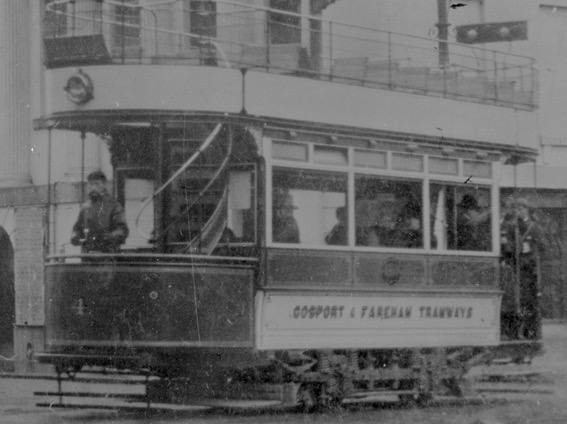
Gosport and Fareham Tramways Tramcar No 4 captured outside Fareham Town Hall in late 1906. Both the motorman and the conductor (on the rear platform) would appear to be wearing informal attire and flat caps. Photo courtesy of the National Tramway Museum. 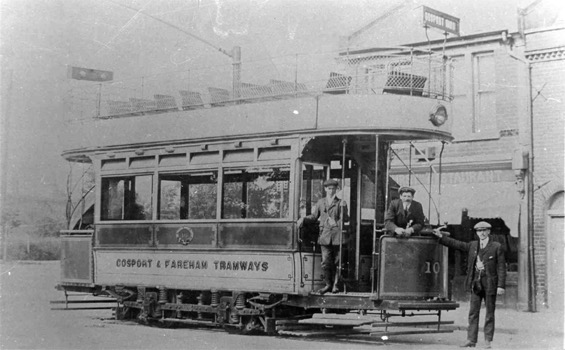
Gosport and Fareham Tramcar No 10 captured at Brockhurst with what would appear to be a motorman and two conductors, suggesting that another tramcar was close by — photo undated, but probably taken in 1906 or 1907. All three men are wearing informal attire. Photo courtesy of the Tramways and Light Railway Society, with thanks to David Voice.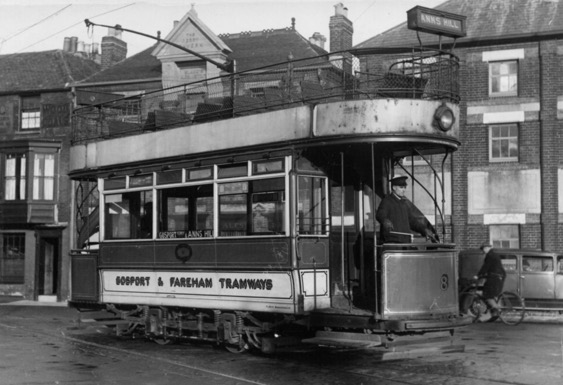
Tramcar No 8 on its last journey, to Ann's Hill, on the closing day of the system, the 31st December 1929. Photo courtesy of the Tramways and Light Railway Society, with thanks to David Voice.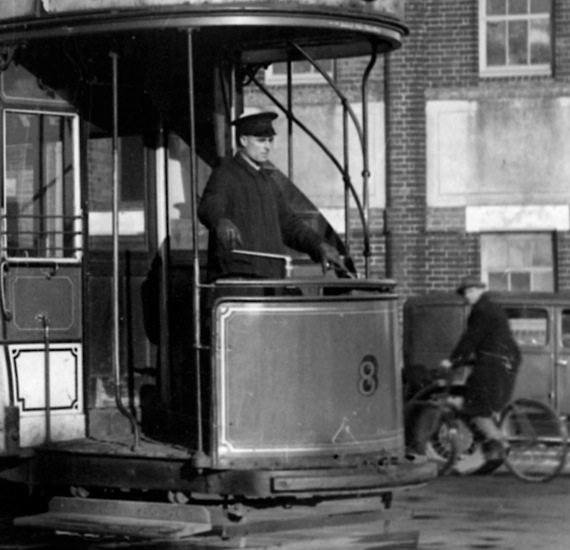
An enlargement of the above photograph showing the motorman, a Mr Stanton, He is wearing a tensioned-crown peaked cap and a greatcoat, all seemingly devoid of insignia.
Female staff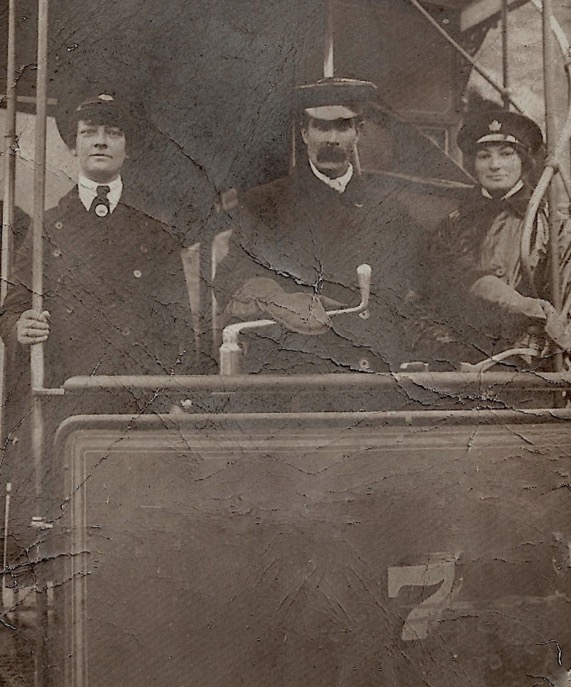
A motorman and two conductresses on the platform of Tramcar No 7 — photo undated, but almost certainly taken during the Great War. Although both ladies are wearing badges on their caps, these are not company-issued, rather they are regimental badges, the wearing of which was common practice, to show support for friends, colleagues or loved ones away on armed service. Photo courtesy of the Stephen Howarth Collection.
A poor quality photograph, puportedly taken in 1919, but one which does show a motorwoman (Ms Helen Blacker), and with all the subjects wearing company-issued top coats with metal buttons. All three of the ladies are wearing regimental badges on their caps.